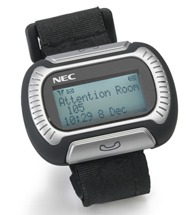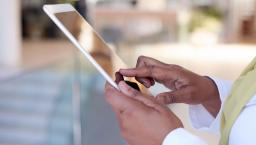 Last month at the Consumer Electronics Show (CES) in Las Vegas, NEC Philips debuted a DECT watch phone intended for use in healthcare and hospitality sectors. This week mobihealthnews caught up with NEC Philips Unified Solutions Manager of Marketing Communications Robert van Amerongen and the company's Business Manager for Mobility Solutions Bert van Koelen to discuss the device's CES launch, criticism of the watch phone's design and what to expect next from NEC-Philips' Mobility solutions group.
Last month at the Consumer Electronics Show (CES) in Las Vegas, NEC Philips debuted a DECT watch phone intended for use in healthcare and hospitality sectors. This week mobihealthnews caught up with NEC Philips Unified Solutions Manager of Marketing Communications Robert van Amerongen and the company's Business Manager for Mobility Solutions Bert van Koelen to discuss the device's CES launch, criticism of the watch phone's design and what to expect next from NEC-Philips' Mobility solutions group.
Could you give me a brief overview of the M155? The M155 is a kind of pager. So, it can receive messages with several levels of urgency. You can confirm messages--so the sender gets a note that you have read it. The device is also a DECT telephone, so you can use it for voice conversations. That's technically what it can do, but there are two intended applications for it. Obviously, in hospitality you can imagine workers in a five-star hotel could equip their staff with these devices. Another application is in the healthcare market, where people can use it in two different ways: Patients who wear the device and use the device as an alarming device. Patients in an elderly care facility could push down two buttons simultaneously and generate an alarm to several spots where the nurses and doctors are--like a kind of nurse call. In response to that alarm, a nurse can make a voice call over the loud speaker of the device at the same moment via live connection and ask this elderly person what's going on. In healthcare, doctors and/or nurses could also wear the device just to be able to respond to alerts, for example, to go to intensive care when their assistance is needed. So, it has a varieties of different types of applications.
van Amerongen: In EMEA, we have quite a lot of applications and installations in, of course, hospitals, but also in residential homes and all kinds of healthcare organizations. In particular, wireless applications are very well-applied. DECT, in particular, as a standard originating from Europe. In the States DECT and IP-DECT are taking off. This is, perhaps, unexpected if you look back 15 years ago, but we see this happening and it's more widespread. We also have a VoWLAN offering, but clearly the solutions based on DECT are more popular. That's what the M115 is doing as well.
Is the M115 available to the U.S. and North American markets or is it just for EMEA? The M115 is a worldwide marketed solution. DECT comes from the EMEA market but we have entered the U.S. market with our DECT solution, which has also included the Australian market and the Far East. DECT is really growing, which is why this messaging device is coming out now.
How will NEC market this product to the healthcare industry? Is DECT popular enough in the U.S. for the M155? We have a strong footprint in Europe as well as the U.S. for healthcare and hospitality: In Europe, for example, we are already in several hundreds of hospitals where our DECT solution is deployed. [The M155] is a very logical extension of that solution. In the U.S. up until this point WLAN is a more common technology [for in-building wireless networks that support voice calls] but when you compare that to Europe, DECT already has a very strong portfolio with ten years of use. That said, WLAN is starting to come to Europe, too. In the U.S. it's the other way around--WLAN is already being used for voice but DECT, especially in its latest version, DECT 6.0, is gaining importance in the U.S. as well.
Engadget and a few other gadget blogs were very critical of the M155's design. Was that criticism fair? Well, I saw one article that compared [the M155] to a somewhat similar LG watch phone that has a keypad on its screen. But in the case of LG's watch phone the intent is to be able to dial any phone number you would like, while in our case the M155 has a number of pre-defined extensions you can dial via simple UI for an alarm or one of the others. It's a very simple list with predefined numbers. As I said before, a message can easily be sent just by pressing two buttons together to sound an alarm. It has really been optimized for this purpose: Giving alarms and initiating hot calls to pre-defined destinations. It's not fair to compare it to watch phones like LG's which has a keypad and a very small screen intended to initiate calls. In this case it's more fair to compare it to a pager device with the added function of a voice call device.
van Amerongen: And our problem with that LG comparison is that, indeed that display is tiny: There is hardly any room for a message's text. All the space is lost for the keypad. So, although it might look handsome it is in fact much less sophisticated when it comes to messaging.
van Koelen: That was, however, very interesting feedback we got on the Bluetooth interface. Indeed, that's not part of the product at this moment, but that's seriously under consideration to add a Bluetooth chip to the phone. That would be very nice.
Besides Bluetooth, what's next for the M155? We are already working on vibrating functionality in the phone so it can work in silent mode. As you can imagine, it can be sometimes disturbing when a phone starts ringing in a hospital. That's already scheduled for the next release.
In NEC-Philips opinion what's the biggest opportunity for wireless technologies in healthcare this year? NEC is working on very hard worldwide on fixed mobile convergence. In healthcare, in particular, you can see that the industry has begun adopting this technology. In smartphones the ability to have WiFi calls and cellular calls is fast becoming an important thing to integrate into the healthcare IT systems. We call our solution for that MobileClient. NEC Unified in the U.S. is currently rolling out this solution and in Europe, too. We certainly see a lot of interest coming from hospitals. A phone well-connected into the hospital IT system with additional functionality for emails and files accessible on the cell phone.











def4.jpg)








